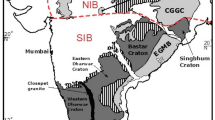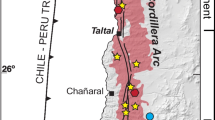Abstract
The southeastern extension of the Austral Islands volcanic chain terminates near 29°S, 140°W at the active Macdonald Seamount. The ‘hotspot’ region near Macdonald consists of at least five other volcanic edifices each more than 500 m high, included in an area about 50–100 km in diameter. On the basis of the sea-floor topography, the southeastern limit of the hotspot area is located about 20 km east of the base of Macdonald, where it is defined by the 3950 m isobath. At the edge of the hotspot area, there is a marked deepening of the seafloor from c.3900 m down to 4000–4300 m. The deeper sea-floor is faulted and heavily sedimented. The Macdonald volcano itself stands 3760 m above the surrounding seafloor, and has a basal diameter of 45 km. Its summit in January 1987 was 39 m below sea level, and it seems likely that Macdonald will emerge at the surface in the near future.
Recent (March and November 1986) phreatic explosions on Macdonald Seamount erupted fragments of ultramafic and mafic plutonic blocks together with basic lapilli (volcaniclastic sand). The plutonic blocks have been variably altered and metamorphosed, and in some cases show signs of mineralisation (disseminated sulphides). The blocks presumably come from deeper levels in the volcanic system. The volcanics so far dredged from Macdonald consist of olivine and clinopyroxene cumulus-enriched basalts, evolved basalts, and mugearite. On the basis of incompatible element variations, simple crystal fractionation seems to be controlling the chemical evolution of Macdonald magmas.
Similar content being viewed by others
References
BarsczusH. G. and LiotardJ. M., 1985, Géochimie des laves du volcan sous-marin Macdonald, Polynésie Francais (Océan Pacific Sud), C. R. Acad. Sci. Paris 300, 915–918.
BrousseR. and Richter de ForgesB., 1980, Laves alcalines et differenciées du volcan sous-marin Macdonald, C. R. Acad. Sci. Paris Ser. D290, 1055–1057.
BurkeK. and WilsonB., 1976, Hotspots on the Earth's Surface, Scient. Am. 235, 46–57.
CheminéeJ. L., HékinianR., TalandierJ., AlbarèdeF., DeveyC. W., FranchteauJ., and LancelotY., 1989, Geology of an Active Hot-Spot: Teahitia-Mehetia Region of the South Central Pacific, Marine Geophys. Res. 11, 27–50.
CroughS. T. and JurdyD. M., 1980, Subducted Lithosphere, Hotspots and the Geoid, Earth Planet. Sci. Lett. 48, 15–22.
DuncanR. A. and McDougallI., 1976, Linear Volcanism in French Polynesia, J. Volcanol. Geotherm. Res. 1, 197–227.
FisherR. V. and SchminckeH.-U., 1984, Pyroclastic Rocks, Springer Verlag, Berlin, 472 pp.
FreyF. A. and ClagueD. A., 1983, Geochemistry of Diverse Basalt Types from Loihi Seamount, Hawaii, Petrogenetic Implications, Earth Planet. Sci. Lett. 66, 337–355.
HerronE. M., 1972, Seafloor Spreading and the Cenozoic History of the East-Central Pacific, Geol. Soc. Am. Bull. 83, 1671–1692.
JohnsonR. H., 1970, Active Submarine Volcanism in the Austral Islands, Science 167, 977–979.
JohnsonR. H., 1980, Seamounts in the Austral Islands Region, National Geographic Soc. Rep. 12, 389–405.
JohnsonR. H., 1984, Exploration of the Submarine Volcanoes in the South Pacific, National Geographic Soc. Rep. 16, 405–419.
JohnsonR. H., and MalahoffA., 1971, Relation of Macdonald Volcano to Migration of Volcanism along the Austral Chain, J. Geophys. Res. 76, 3282–3290.
Klein, F. W. and Koyanagi, R. Y., 1979, Seismicity of Kilauea and Loihi volcanoes, Hawaii, Hawaii Symposium on Intraplate Volcanism and Submarine Volcanism, Abstracts, p. 127.
KokelaarP., 1986, Magma-Water Interactions in Subaqueous and Emergent Basaltic Volcanism, Bull. Volcanol. 48, 275–289.
LanphereM., 1983, 87Sr/86Sr Ratios for Basalts from Loihi Seamount, Hawaii, Earth Planet. Sci. Lett. 66, 380–387.
Malahoff, A., 1986, Geology of the Summit of Loihi Submarine Volcano, U.S. Geol. Surv. Prof. Pap. 1350, Chap. 6.
MalahoffA., McMurtryG. M., WiltshireJ. C., and YehH.-W., 1982, Geology and Chemistry of Hydrothermal Deposits from Active Submarine Volcano Loihi, Hawaii, Nature 298, 234–239.
McBirneyA. R. and AokiK-I., 1968, Petrology of the Island of Tahiti, Geol. Soc. Am. Mem. 116, 523–556.
MooreJ. G., ClagueD. A., and NormarkW. R., 1982, Diverse Basalt Types from Loihi Seamount, Hawaii, Geology 10, 88–92.
MorganW. J. 1971, ‘Convection Plumes in the Lower Mantle’, Nature 230, 42–43.
MorganW. J., 1972, Plate Motions and Deep Mantle Convection, Geol. Soc. Am. Mem. 132, 7–22.
NorrisA. and JohnsonR. H., 1969, Submarine Volcanic Eruptions Recently Located in the Pacific by Sofar Hydrophones, J. Geophys. Res. 74, 650–664.
PalaczZ. A. and SaundersA. D., 1986, Coupled Trace Element and Isotope Enrichment in the Cook-Austral-Samoa Islands, Southwest Pacific, Earth Planet. Sci. Lett. 79, 270–280.
RoedderP. L. and EmslieR. F., 1970, Olivine-Liquid Equilibrium, Contrib. Mineral. Petrol. 29, 275–289.
SailorR. V. and OkalE. A., 1983, Applications of Seasat Altimeter Data in Seismotectonic Studies of the South-Central Pacific, J. Geophys. Res. 88, 1572–1580.
StefanikM. and JurdyD. M., 1984, The Distribution of Hotspots, J. Geophys. Res. 89, 9919–9925.
TalandierJ. and OkalE. A., 1983, The Volcanoseismic Swarms of 1981–1983 in the Tahiti-Mehetia Area, J. Geophys. Res. 89, 11216–11234.
TalandierJ. and OkalE. A., 1984, New Survey of Macdonald Seamount, South Central Pacific, following Volcanoseismic Activity, 1977–1983, Geophys. Res. Lett. 1, 813–816.
TracyR. J., 1980, Petrology and Genetic Significance of an Ultramafic Xenolith Suite from Tahiti, Earth Planet. Sci. Lett. 48, 80–96.
VidalP., ChauvelC., and BrousseR., 1984, Large Mantle Heterogeneity beneath French Polynesia, Nature 307, 536–538.
VogtP. R. and SmootN. C., 1984, The Geisha Guyots, Multibeam Bathymetry and Morphometric Interpretation, J. Geophys. Res. 89, 11085–11107.
WilsonJ. T., 1965, A New Class of Faults and their Bearing on Continental Drift, Nature 207, 343–347.
Author information
Authors and Affiliations
Rights and permissions
About this article
Cite this article
Stoffers, P., Botz, R., Cheminée, J.L. et al. Geology of Macdonald Seamount region, Austral Islands: Recent hotspot volcanism in the south Pacific. Mar Geophys Res 11, 101–112 (1989). https://doi.org/10.1007/BF00285661
Received:
Revised:
Issue Date:
DOI: https://doi.org/10.1007/BF00285661




